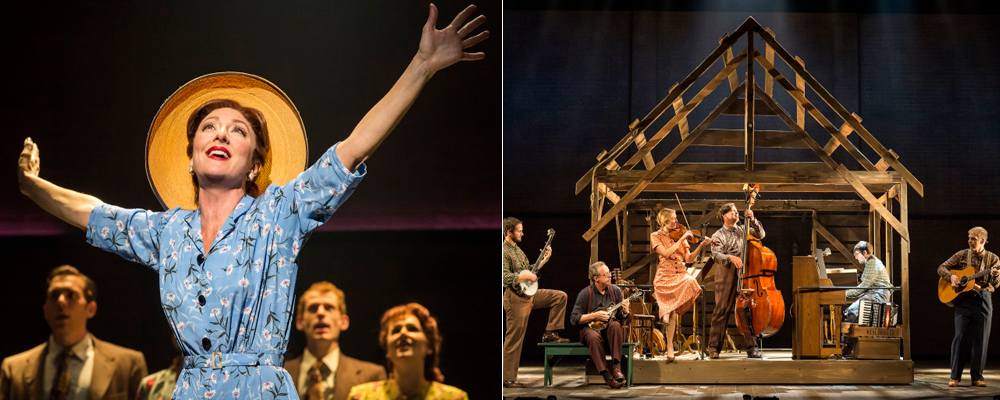Steve Martin’s ‘Bright Star’ Is an Enrapturing Bluegrass Romance
Alci Rengifo
Nostalgia for the Greatest Generation returns to the stage with “Bright Star,” the Tony Award-nominated musical written by award-winning actor Steve Martin and Grammy winner Edie Brickell. The production is now slated for a national tour beginning March 13, 2018 in Houston, TX, moving next to Worcester, MA, then Raleigh, NC, New Haven, CT, Dallas, TX and ending its run in Charlotte, NC July 1, 2018. The musical is a celebration of some universal experiences filtered through classic Americana, such as the struggling artist, the old culture of print journalism and the search for a missing son. While a huge pool of talent helped make the production a reality, there is little doubt that the spirit of the narrative is all Martin in its charm, wit and serious themes masked with tender humor. In another nod to its pure American roots, the music is an immersive hybrid of stage and bluegrass numbers, featuring music which has already topped the charts.
The musical shifts between 1945 and 1924 and centers on two main characters: Alice Murphy (Carmen Cusack), the editor of the Journal, a publication at Hayes Creek, and Billy Cane (A.J. Shively), an aspiring writer and World War II vet seeking the Holy Grail of getting published. Billy reunites with his father and catches up with childhood friend Margo (Hannah Elless) before taking his stories to the Journal. He manages to hustle his material to Alice who starts reminiscing about the past, specifically 1924, when as a 16-year-old she fell madly in love with the son of a local mayor. An eventual pregnancy ends with a forced adoption and Alice has been haunted by the need to find her son ever since. Meanwhile in 1945 Billy must choose between dedicating himself fully to his dreams of writing, even as his heart feels pulled by previously hidden feelings for Margo.
“Bright Star” is a breath of pure nostalgia used to tell a simple yet very human story. This is evident in the music itself. The opening number, a driving reflection sung by Alice as she introduces the tale, has a wonderful folky ambiance with lines like “I left my clothes on that cold river rock/my cares and my woes rolled up in my socks/I laid down on that mountain stream/and the icy water rushed over me.” The musical is infused with this kind of beautiful envisioning of a bygone era. The show’s “Finale” also has a hymnal quality to it with the characters singing “I have a vision/of how life will go/everything is wonderful/and I love you so/Love let me lift this veil of darkness.” Other songs like “Bright Star,” which is sung as Billy makes his way to pitch his material, are also full of a joyful step that can almost feel out of place in this current historical moment. Lyrics in the song announce “You never know what life will bring/only what you bring to life/hopes and dreams and fine imaginings/they happen in their own good time.” It’s corn, but because Martin and Brickell craft it with such heart and soul it can also feel refreshing. This helps explain why the original Broadway cast recording topped several Billboard charts.
The rest of the production itself is a good time where microcosmic characters experience life’s big challenges. A.J. Shively fits so well in the role of Billy that he might very well be a time traveler from the 1940s. Hannah Elless as Margo could have stepped out of a Norman Rockwell painting. She evokes a tenderness and warmth, eternally in love with Billy even if he doesn’t realize it was meant to be. Elless particularly delivers during the rousing number “Sun is Gonna Shine” Carmen Cusack is a real force as Alice. She appears onstage with a Roman profile suggesting a Douglas Sirk star while conjuring deep sadness and then wondrous joy.
It is these performances that carry us along with a plot that only seems generic on the surface, because like a lot of good corn or pop, there are deeper, universal themes underneath. This is why whether in novels, cinema or the stage, simple romances sometimes outlast denser material in the public memory, because they have direct themes that resonate with everyone. Martin and his collaborators know how to tape into the warmth and power of nostalgia. The set design by Eugene Lee is a vision out of pure American memory. He is obviously inspired by a John Steinbeck meets Rockwell sense of the American 20s and 40s. Shacks, mountains and valleys are evoked with a glistening romanticism. This is a musical set in what is perceived to be an age of simpler values and a different pace of life.
But in the end it is all about the music. It is the wondrous score that makes this musical come alive as a vibrant experience full of tender moods, romantic imagination and escape from our ever so dark era. “Bright Star” returns to a time long gone, and asks us to leave our cares at the door and sing along.
“Bright Star” begins its national tour March 13, 2018 in Houston, TX, moving next to Worcester, MA, then Raleigh, NC, New Haven, CT, and Dallas, TX with its final performance in Charlotte, NC on July 1, 2018.



